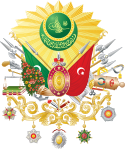Mehmed VI
| Ten artykuł od 2022-05 wymaga zweryfikowania podanych informacji. |
 | |
 | |
| Sułtan Imperium Osmańskiego | |
| Okres | od 4 lipca 1918 |
|---|---|
| Poprzednik | |
| Dane biograficzne | |
| Dynastia | |
| Data i miejsce urodzenia | |
| Data i miejsce śmierci | |
| Miejsce spoczynku | |
| Ojciec | |
| Matka | Gülüstü |
| Odznaczenia | |
Mehmed VI, właśc. Mehmed Vahdettin lub Mehmed Vahideddin (ur. 14 stycznia 1861 w Konstantynopolu, zm. 16 maja 1926 w San Remo) – ostatni sułtan Imperium Osmańskiego.
Życiorys
W 1916 został następcą tronu, po tym gdy Yusuf Izzeddin najstarszy syn sułtana Abdülaziza popełnił samobójstwo. Został koronowany 4 lipca 1918.
Objął władzę w najbardziej dramatycznym dla imperium momencie, ponieważ przegrało ono I wojnę światową, a spora jego część została podzielona pomiędzy Francję i Wielką Brytanię. Terytoria te zostały później uznane za mandatowe. W 1920 Turcja podpisała traktat z Sèvres, który dokonując podziału dawnego imperium m.in. potwierdził mandaty, ograniczył wielkość sił zbrojnych oraz wprowadził kapitulacje, czyli wyjęcie cudzoziemców spod sądów tureckich. Wywołało to opór tureckich nacjonalistów. Nowy rząd pod przywództwem Mustafy Kemala odsunął skompromitowanych poprzedników przejmując władzę. W związku z tymi wydarzeniami sułtanat został zniesiony 1 listopada 1922.
Odsunięty od władzy sułtan wyjechał z kraju na pokładzie brytyjskiego pancernika HMS "Malaya" kilkanaście dni później. Zmarł na wygnaniu w San Remo.
Media użyte na tej stronie
Every sultan of the Ottoman Empire had his own monogram, called the tughra, which served as a royal symbol. A coat of arms in the European heraldic sense was created in the late 19th century. Hampton Court requested from the Ottoman Empire a coat of arms to be included in their collection. As the coat of arms had not been previously used in the Ottoman Empire, it was designed after this request, and the final design was adopted by Sultan Abdul Hamid II on 17 April 1882.
Autor: McOleo, Licencja: CC BY 3.0
Ribbon bar of the Order of Glory (Ottoman Empire)
Order of Imtiaz - ribbon
Tughra (i.e., seal or signature) of Mehmed VI, last Sultan of the Ottoman Empire (1918-1922). An explanation of the different elements composing the tughra can be found here.
36. i ostatni Sułtan Imperium Osmańskiego również 115-ci Kalif İslamu; Mehmed VI.
Autor: Buho07, Licencja: CC BY-SA 3.0
Ottoman Imperial Standard, Late 19th and early 20th Century. Each Sultan had his own Tughra.







